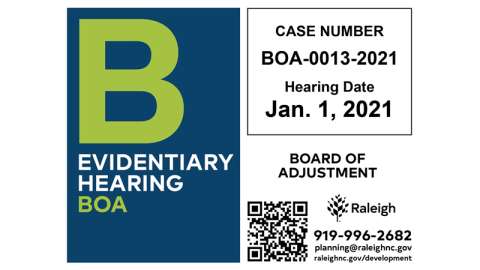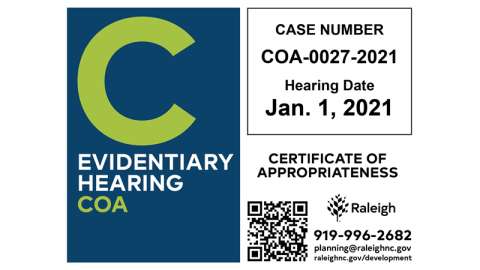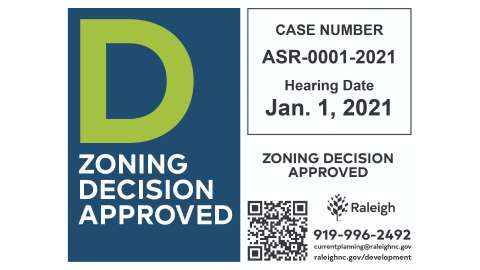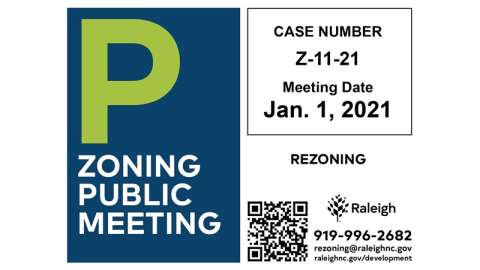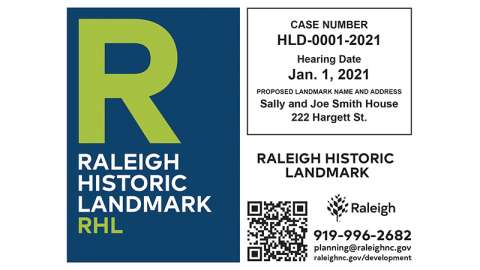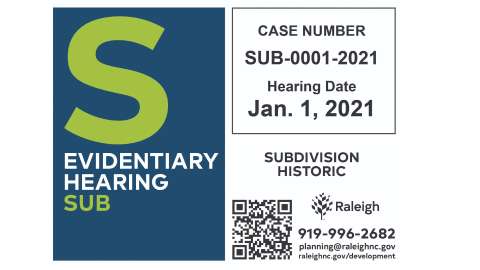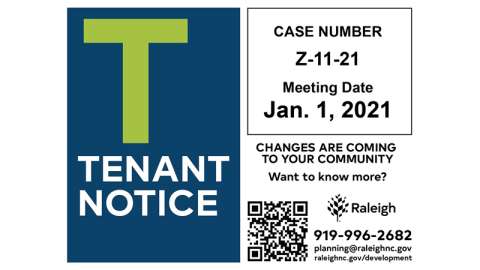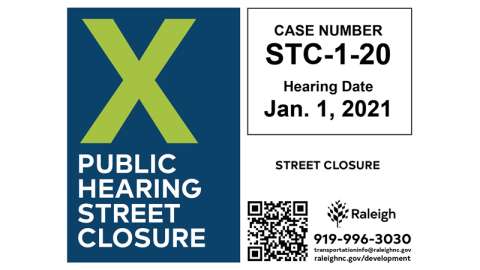Jump To:
Have you seen one of these signs around Raleigh? Each of these signs provides you with details about a project happening near or at the sign's location.
The QR code on each sign takes you to the Current Development Activity page, which is a hub for all development cases currently happening in the city.
Learn more below about what each sign means and why it might matter to you.
A – Design Review Commission
This sign tells you a Design Alternate request has been filed with the Design Review Commission for a project at/near the sign’s location. An evidentiary hearing is required during this process. The sign tells you:
- A hearing date
- A project case number
UDO reference: 8.3, 8.4
Sign contact: Email Kasey Evans or call 919-996-2689
Did you know? The Unified Development Ordinance (UDO) sets rules for the way buildings, yards, and streets are designed. Sometimes, a developer’s team proposes designs that do not meet those standards but otherwise meet the city’s goal of creating a high-quality built environment. When that happens, developers can request a Design Alternate that is reviewed by the city’s Design Review Commission, which makes sure the request meets the city’s goals.
At the hearing, both the applicant and other interested parties present evidence in support of or in opposition to the application. Visit the Design Review Commission for more information on the agenda, cases, and meeting location.
B - BOA Evidentiary Hearing
This sign tells you that an application has been filed with the Board of Adjustment (BOA) for a project at/near the sign’s location. An evidentiary hearing is required during this process. The sign tells you:
- A hearing date
- A project case number
UDO reference: 10.2.9, 10.2.10, 10.2.11, 10.2.18
Sign contacts: Email Eric Hodge or call 919-996-2639, Email Justin Bucher or call 919-996-2625
Did you know? A BOA application is filed to request permission to break a development rule (UDO) because following the rules causes significant difficulty for the project. Oftentimes, these requests are made for things that prevent conforming to the rules, such as an oddly shaped lot or natural impediment.
At the hearing, both the applicant and other interested parties present evidence in support of or in opposition to the application. Visit the BOA webpage for more information on the agenda, cases, and meeting location.
C - COA Evidentiary Hearing
This sign tells you that an application has been filed with the RHDC Certificate of Appropriateness (COA) Committee for a project at/near the sign’s location. An evidentiary hearing is required for this process. The sign tells you:
- A hearing date
- A case number
- The project address
- Description of the proposed exterior changes
UDO reference: 10.1.4.D.1; 10.2.15
Sign contact: Email the Historic Preservation Team or call 919-996-4478
Did you know? The COA Committee is part of the Raleigh Historic Development Commission (RHDC). A major work COA application is usually filed for exterior work like additions, new construction, demolition, tall fences, and large accessory buildings. A COA is required for exterior work within a historic overlay district or to a historic landmark.
At the evidentiary hearing, both the applicant and other interested parties present evidence in support of or in opposition to the application. The current agenda and meeting information are available online through the RHDC webpage.
D - Zoning Decision Approved
This sign means that an administrative approval has been issued for a property at/near the sign’s location. This sign is for information purposes only and there is no action necessary on your part. The sign tells you:
- Project case number
- Project address
- Project description (not required on all signs)
UDO reference: 10.2.8.D.1.d
Sign contact: Submit to Ask Raleigh or call 919-996-2492
Did you know? While this sign may be related to an infill project, you will often see this sign because the project includes a new building of 25,000 square feet or more in size. The project may also include an addition that increases an existing building by more than 10% or 25,000 square feet. If these projects are located within 100 feet of property zoned R-1, R-2, R-4, R-6, or R-10, a sign is posted.
P - Zoning Public Meeting
This sign means a public meeting has been scheduled to review a rezoning request for a project near/at the sign’s location. The sign tells you:
- A meeting date
- A project case number
- The project address (if the case number is not available)
UDO reference: 10.2.4
Sign contact: Email Sarah Shaughnessy or call 919-996-2234
Did you know? The Planning Commission considers requested changes to Raleigh’s zoning map and makes recommendations to City Council.
Visit the Planning Commission webpage for more information on agenda, cases, and meeting location.
R - Raleigh Historic Landmark
This sign tells you that an application has been filed requesting a Raleigh Historic Landmark designation. A joint public hearing with City Council and the Raleigh Historic Development Commission (RHDC) is required for this process. The sign tells you:
- A hearing date
- A case number
- Proposed landmark address
- Proposed landmark name
UDO reference: 10.1.4.D.1; 10.2.16
Sign contact: Email the Historic Preservation Team or call 919-996-4478
Did you know? Applications for Raleigh Historic Landmark designation are reviewed, and recommendations are made by the RHDC, but the final decision is made by City Council. Applications are also reviewed by the State Historic Preservation Office. The application includes a report on the history of the property as well as photographs
S - Subdivision Evidentiary Hearing
This sign tells you that an application has been filed for a subdivision at/near the sign’s location in a historic overlay district. An evidentiary hearing is required during this process. The sign tells you:
- A hearing date
- Current project address
- Project case number
- Description of the proposed subdivision
UDO reference: 10.1.4.D.2; 10.2.5
Sign contact: Email the Historic Preservation Team or call 919-996-4478
Did you know? Only subdivision applications in a historic overlay district or to a historic landmark have this sign requirement. After meeting all administrative code requirements, the final decision on the subdivision is made by the COA Committee of the RHDC.
At the hearing, both the applicant and other interested parties present evidence in support of or in opposition to the application. The current agenda and meeting information are available online through the RHDC webpage.
T - Tenant Notice
This sign is posted to notify residents of a tenant-occupied property (like an apartment building) about a project in their area. When mailed notice is required for a development application, tenants are required to be notified along with property owners, so when a mailing address is not available this sign is posted instead.
Depending on the project, the content of this sign can vary, but there is likely a project case number on the sign, as well as a hearing/meeting date associated with one of the following applications or project types:
- Rezoning
- Text change to zoning conditions
- Historic subdivisions
- Site plan review
- Special use permits
- Variances
- Certificate of Appropriateness (COA)
- Design alternates
UDO reference: 10.2.1.C
Sign contact: Submit to Ask Raleigh or call 919-996-2500
Did you know? Unlike other development applications that require notice to properties within 100 feet of the site, Rezoning cases require a 1000-foot radius for second neighborhood meetings and a 500-foot radius for all other notices.
X – Street Closure Public Hearing
This sign tells you that a petition has been filed with the City of Raleigh Transportation Department for a permanent closure of a public street or alley (i.e., public right-of-way) near the sign’s location. A public hearing is required during this process. Generally, the sign tells you:
- The hearing date and location
- The project case number
UDO reference: The procedure for closing public streets and alleys within the City is dictated by State Law rather than the UDO, as outlined in North Carolina General Statute § 160A-299. More information is available here: https://www.ncleg.gov/EnactedLegislation/Statutes/PDF/BySection/Chapter_160A/GS_160A-299.pdf.
Did you know? Street closure petitions under § 160A-299 are a request to close a public right-of-way that has been dedicated to the City. This process applies to requests to permanently close the public right-of-way. It does not apply to temporary street closings, public nuisance abatement, or traffic control for special events. To learn more, see the Transportation Department’s Street Closings page. View maps of active street closing cases.
Z - Zoning Public Hearing
This sign means a public hearing has been scheduled in response to a rezoning request for a project at the sign’s location. The sign tells you:
- A meeting date
- A project case number
UDO reference: 10.2.4
Sign contact: Email Sarah Shaughnessy or call 919-996-2234
Did you know? The City Council makes the final decision about whether or not a property should be rezoned.
Visit the Public Hearings page for information on cases, speaking during the public hearing, and meeting location.

